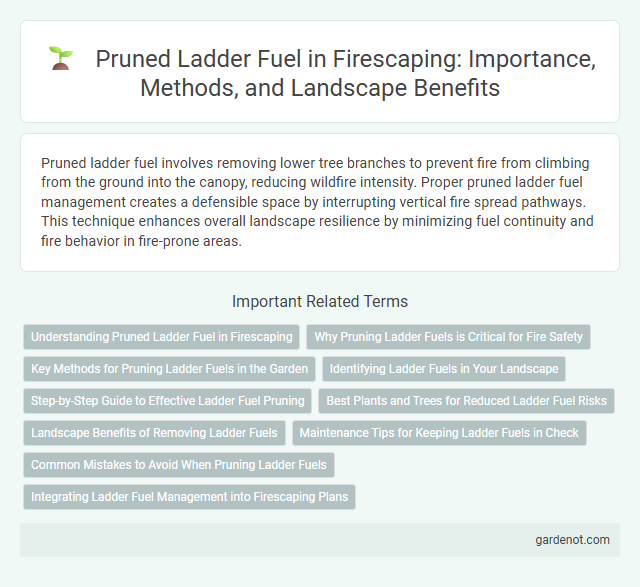Pruned ladder fuel involves removing lower tree branches to prevent fire from climbing from the ground into the canopy, reducing wildfire intensity. Proper pruned ladder fuel management creates a defensible space by interrupting vertical fire spread pathways. This technique enhances overall landscape resilience by minimizing fuel continuity and fire behavior in fire-prone areas.
Understanding Pruned Ladder Fuel in Firescaping
Pruned ladder fuel refers to the removal of lower tree branches and vegetation that allow fire to climb from the ground into the canopy, significantly reducing wildfire risk. Effective firescaping involves strategically pruning ladder fuels to create vertical and horizontal separation between vegetation layers, thereby slowing fire spread and protecting properties. Maintaining a minimum clearance of six to ten feet between the ground and tree branches is recommended to diminish the chances of crown fires during wildfire events.
Why Pruning Ladder Fuels is Critical for Fire Safety
Pruning ladder fuels is critical for fire safety because it removes low-hanging branches and dense vegetation that enable fires to climb from the ground into tree canopies, increasing fire intensity and spread. This practice reduces the vertical continuity of flammable materials, effectively creating defensible space that slows wildfire progression and aids firefighting efforts. Maintaining proper clearance between ladder fuels and the ground decreases the risk of crown fires, which are more destructive and harder to control.
Key Methods for Pruning Ladder Fuels in the Garden
Effective pruning of ladder fuels involves removing lower tree branches and dense underbrush to prevent fire from climbing from the ground to the canopy. Key methods include selectively cutting branches within 6 to 10 feet from the ground and thinning shrubs to increase vertical spacing between vegetation layers. Proper ladder fuel management reduces fire intensity and enhances garden defensibility during wildfire events.
Identifying Ladder Fuels in Your Landscape
Pruned ladder fuels are vegetation layers that allow wildfires to climb from the ground into the tree canopy, increasing fire intensity and spread. Identifying ladder fuels in your landscape involves assessing shrubs, low-hanging branches, and small trees that connect ground fuels to higher foliage. Effective firescaping requires removing or pruning these fuels to create vertical spacing and reduce wildfire risks.
Step-by-Step Guide to Effective Ladder Fuel Pruning
Begin ladder fuel pruning by identifying and removing all low-hanging branches within 10 feet of the ground to eliminate fire pathways. Next, trim branches from shrubs and trees up to a height of 6 to 10 feet, ensuring spacing between vegetation layers to prevent fire from climbing vertically. Regularly dispose of pruned materials and monitor regrowth to maintain an effective fire-resistant landscape.
Best Plants and Trees for Reduced Ladder Fuel Risks
Selecting fire-resistant plants like manzanita, California lilac, and rosemary helps minimize ladder fuel risks by limiting vertical fuel continuity. Opting for low-growing, well-spaced trees such as blue oak and ponderosa pine further reduces the potential for flame climbing from ground vegetation to tree canopies. Regularly pruning and maintaining these species ensures safer defensible space around homes in fire-prone areas.
Landscape Benefits of Removing Ladder Fuels
Removing pruned ladder fuels significantly reduces wildfire risk by preventing flames from climbing from ground vegetation to tree canopies, thereby protecting property and preserving landscape integrity. This practice enhances plant health by promoting better air circulation and sunlight penetration, encouraging native species growth and reducing invasive plants. Effective firescaping with ladder fuel removal supports sustainable ecosystems and safeguards valuable landscape assets.
Maintenance Tips for Keeping Ladder Fuels in Check
Regularly pruned ladder fuels prevent the vertical spread of wildfires by maintaining a safe distance between ground vegetation and tree canopies. Use tools like hand pruners or pole pruners to remove lower branches up to 6-10 feet from the ground, promoting safe ember flow restriction. Consistent seasonal inspection and removal of dead or low-hanging branches improve fire resistance and overall landscape health.
Common Mistakes to Avoid When Pruning Ladder Fuels
Pruned ladder fuels should be removed at least 10 feet above the ground to prevent fire from climbing from the surface to the canopy, avoiding the common mistake of cutting too low. Neglecting to prune small side branches can leave hidden ladder fuels that facilitate fire spread, reducing the effectiveness of fire-resistant landscaping. Over-pruning large limbs can weaken tree health and create entry points for pests, so proper balance is essential for maintaining fire safety and plant vitality.
Integrating Ladder Fuel Management into Firescaping Plans
Pruned ladder fuel reduces vertical fuel continuity, minimizing fire's ability to climb from ground to canopy and enhancing overall firebreak effectiveness. Integrating ladder fuel management into firescaping plans involves selective trimming of lower tree branches and removal of dense undergrowth to create defensible spaces around structures. This strategic pruning supports fire resilience by disrupting pathways for flames and lowering fire intensity near vulnerable properties.
Pruned ladder fuel Infographic

 gardenot.com
gardenot.com